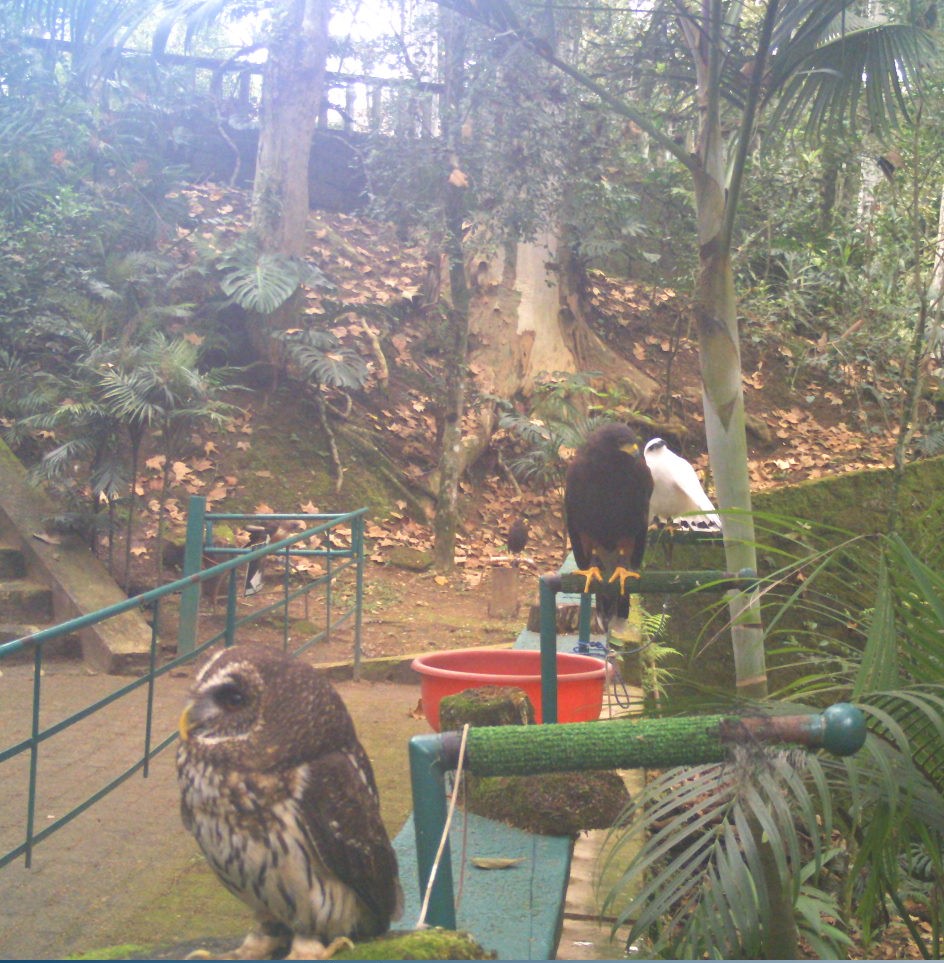Nocturnal birds of prey in captivity: a study in the owl Ciccaba virgata (Strigidae)
Aves rapaces nocturnas en cautiverio: estudio en búho Ciccaba virgata (Strigidae)


This work is licensed under a Creative Commons Attribution-NonCommercial-ShareAlike 4.0 International License.
Show authors biography
Objective. To observe the behavior, hormonal patterns, and welfare in captive mottled owl Ciccaba virgata (Strigidae). Materials and methods. The study was conducted at environmental management units (UMA) in Xalapa, Mexico, on six owls (two females in one enclosure, one male and one female in another, both without public display and with environmental enrichment, and two isolated individuals, kept caged or perched, with daytime public display). Behaviors were monitored in each pair or individual during 120 hours of filming (60 h during the day and 60 h at night). Concentrations of fecal metabolites of corticosterone, estradiol, and progesterone were measured, and welfare was assessed with observational indicators and surveys. Results. The paired owls showed normal behaviors and excellent welfare (95.5%), while the isolated individuals showed undesirable behaviors and regular welfare (51.4%). Of 24 behaviors considered in an ethogram, 11 were observed repeatedly in all specimens. The isolated birds had higher agonistic, feeding, and individual activity (p<0.001) than the paired birds, although it did not result in lower levels of corticosterone (p=0.09) nor estrogens (p=0.29) in females, only in progesterone (p=0.001). Conclusions. In captive mottled owls, daytime display and inadequate facilities promote the presence of undesirable behaviors that can affect their welfare. Therefore, the use of enrichment measures, such as larger enclosures, feeding at night, and pair housing (female and male, or two females) should be considered to reduce the negative effects of captivity and increase their welfare.
Article visits 637 | PDF visits
Downloads
- Dickens, M, Romero L. A consensus endocrine profile for chronically stressed wild animals does not exist. Gen. Comp. Endocrinol. 2013; 191:177–189. http://dx.doi.org/10.1016/j.ygcen.2013.06.014
- Valencia-Herverth J, Ortiz-Pulido R, Enríquez, PL. Riqueza y distribución espacial de rapaces nocturnas en Hidalgo, México. Huitzil. 2012; 13(2):116-129. https://www.mexorn.org/index.php/huitzil/article/view/158/136
- Contreras PC, Ubillas MJ. Evaluación del bienestar animal de aves rapaces en rehabilitación, descripción de técnicas que lo promuevan y mejoren su tasa de reintroducción. Av Cienc Vet. 2013; 28(2):1-12. https://avancesveterinaria.uchile.cl/index.php/ACV/article/view/30201/31975
- Almasi B. Roulin A, Jenni L. Corticosterone shifts reproductive behaviour towards self-maintenance in the barn owl and is linked to melanin-based coloration in females. Horm Behav. 2013; 64(1):161–171. http://dx.doi.org/10.1016/j.yhbeh.2013.03.001
- Bailoo JD, Murphy E, Boada-Saña M, Varholick JA, Hintze S, Baussière C, Hahn KC, Göpfert C, Palme R, Voelkl B, Würbel H. Effects of Cage Enrichment on Behavior, Welfare and Outcome Variability in Female Mice. Front Behav Neurosci. 2018; 12:232. https://doi.org/10.3389/fnbeh.2018.00232
- Almeida A, Palme R, Moreira N. How environmental enrichment affects behavioral and glucocorticoids responses in captive blue-and-yellow macaws (Ara ararauna). Appl Anim Behav Sci. 2018; 201:125-135. https://doi.org/10.1016/j.applanim.2017.12.019
- SIEGVER. Xalapa. Sistema de Información Estadística y Geográfica del Estado de Veracruz de Ignacio de la Llave: México; 2020. http://ceieg.veracruz.gob.mx/wp-content/uploads/sites/21/2020/12/Xalapa_2020.pdf
- Palme R. Monitoring stress hormone metabolites as a useful, non-invasive tool for welfare assessment in farm animals. Anim Welf. 2012; 21:331–337. https://doi.org/10.7120/09627286.21.3.331
- Miller, E. Minimum Standards for Wildlife Rehabilitation. 4a ed. Nat. Wildl. Rehab Assoc: USA; 2012. https://theiwrc.org/wp-content/uploads/2011/05/Standards-4th-Ed-2012-final.pdf.
- Fernández R, Quintana A, Panglieri N. Implementación del enriquecimiento ambiental para el mejoramiento del bienestar animal en aves rapaces nocturnas en el jardín botánico y zoológico de Asunción. Compend Cienc Vet. 2013; 3(2):7-12. http://www.vet.una.py/dict/webccv05.html
- Hoehfurtner T, Wilkinson A, Walker M, Burman OHP. Does enclosure size influence the behaviour & welfare of captive snakes (Pantherophis guttatus)? Appl Anim Behav Sci. 2021; 243:105425. https://doi.org/10.1016/j.applanim.2021.105435
- Liu H, Duan H, Wang C. Effects of Ambient Environmental Factors on the Stereotypic Behaviors of Giant Pandas (Ailuropoda melanoleuca). PLoS ONE. 2017; 12(1):e0170167. https://doi.org/10.1371/journal.pone.0170167
- de Busserolles F, Cortesi F, Helvik JV, Davies WIL, Templin RM, Sullivan RKP, Michell CT, Mountford JK, Collin SP, Irigoien X, Kaartvedt S, Marshall J. Pushing the limits of photoreception in twilight condition: The rod-like cone retina of the deep-sea pearlsides. Sci Adv. 2017; 3:eaao4709. https://www.science.org/doi/pdf/10.1126/sciadv.aao4709
- Rincón M, Sáchica M, Torres N, Pachón N. Las aves rapaces nocturnas (búhos y lechuzas): aportes al estudio de su popularidad. Bio-graf. 2016; 9(7):43-53. https://doi.org/10.17227/20271034.vol.9num.17bio-grafia43.53.
- Russart KLG, Nelson RJ. Artificial light at night alters behavior in laboratory and wild animals. J Exp Zool A Ecol Integr Physiol. 2018; 329(8-9):401–408. https://doi.org/10.1002/jez.2173
- Sneddon J, Lee J, Ballantyne R, Packer J. Animal welfare values and tourist behavior. Ann Tour Res. 2016; 57:234–278. https://doi.org/10.1016/j.annals.2016.01.006.
- De La Ossa VJ. Anotaciones sobre bienestar animal en zoológicos. Rev Colombiana Cienc Anim - RECIA 2016; 8(Supl):411-423. https://doi.org/10.24188/recia.v8.n0.2016.398.
- Yon L, Williams E, Harvey ND, Asher L. Development of a behavioural welfare assessment tool for routine use with captive elephants. PLoS ONE. 2019; 14(2):e0210783. https://doi.org/10.1371/journal.pone.0210783
- Raap T, Thys B, Grunst AS, Grunst MS, Pinxten R, Eens M. Personality and artificial light at night in a semi-urban songbird population: No evidence for personality-dependent sampling bias, avoidance or disruptive effects on sleep behaviour. Env Pollution. 2018; 24:1317-1324. https://doi.org/10.1016/j.envpol.2018.09.037
- Rasidi EK, Cornejo J, Managing the Health of Captive Flocks of Birds. Clin. North Am Exot Anim Pract. 2021; 24:521–530. https://doi.org/10.1016/j.cvex.2021.05.004
- Schoenle LA, Dudek AM, Moore IT, Bonier F. Red winged blackbirds (Agelaius phoeniceus) with higher baseline glucocorticoids also invest less in incubation and clutch mass. Horm Behav. 2017; 90:1-7. https://doi.org/10.1016/j.yhbeh.2017.02.002
- Puehringer-Sturmayr V, Wascher C, Loretto M, Palme R, Stoewe M, Kotrschal K, Frigerio D. Seasonal differences of corticosterone metabolite concentrationsand parasite burden in northernbald ibis (Geronticus eremita): The role of affiliative interactions. PLoS ONE 2018; 13(1):16. https://doi.org/10.1371/journal.pone.0191441.
- Arcos, F.P., Estay, S.A., Oidor, M.A., Quiroz, L.U., Ramírez, J.S. ¿Las lechuzas de campanario (Tyto alba) son estrictamente nocturnas? Cuidado parental de una hembra en cautiverio. Rev Vet. 2022; 33(1):41-43. https://revistas.unne.edu.ar/index.php/vet/article/view/5877
- Kapusta J, Kruczek M, Pochron E, Olejniczak P. Welfare of encaged rodents: Species specific behavioral reaction of voles to new enrichment items. Appl Anim Behav Sci. 2022; 246:105522. https://doi.org/10.1016/j.applanim.2021.105522
- Ward SJ, Melfi V. Keeper-Animal Interactions: Differences between the Behaviour of Zoo Animals Affect Stockmanship. PLoS ONE. 2015; 10(10):e0140237. https://doi:10.1371/journal.pone.0140237























